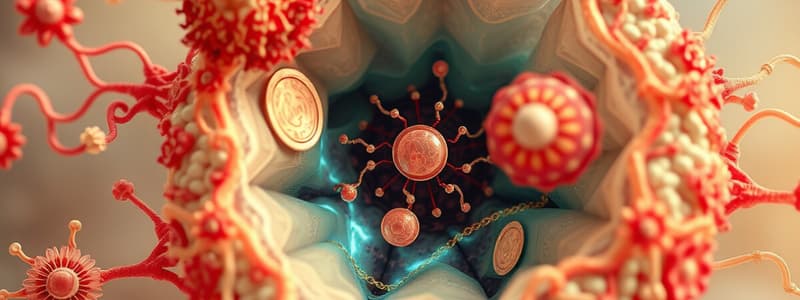Podcast
Questions and Answers
Biology is the study of all living things and the smallest living unit of an organism is called a ______.
Biology is the study of all living things and the smallest living unit of an organism is called a ______.
cell
All cells contain living material called ______.
All cells contain living material called ______.
cytoplasm
Prokaryotic organisms are those whose cells lack a ______.
Prokaryotic organisms are those whose cells lack a ______.
nucleus
Cells that contain a nucleus and other membrane-bound organelles are referred to as ______.
Cells that contain a nucleus and other membrane-bound organelles are referred to as ______.
The simplest cells are called ______.
The simplest cells are called ______.
Organisms made up of one cell are known as ______ organisms.
Organisms made up of one cell are known as ______ organisms.
Fungi do not undergo photosynthesis because they do not contain the green pigment ______.
Fungi do not undergo photosynthesis because they do not contain the green pigment ______.
All living things share common characteristics, including the ability to ______.
All living things share common characteristics, including the ability to ______.
Photosynthesis converts light energy into ______ energy.
Photosynthesis converts light energy into ______ energy.
Autotrophs can make their own ______.
Autotrophs can make their own ______.
Heterotrophs cannot make their own food, they must consume other ______.
Heterotrophs cannot make their own food, they must consume other ______.
Herbivores eat ______.
Herbivores eat ______.
Aerobic respiration occurs ______ oxygen.
Aerobic respiration occurs ______ oxygen.
Anabolism involves ______, while catabolism involves breaking.
Anabolism involves ______, while catabolism involves breaking.
All organisms respond to ______ in order to survive and reproduce.
All organisms respond to ______ in order to survive and reproduce.
Homeostasis refers to a ______ or stable condition.
Homeostasis refers to a ______ or stable condition.
Sexual reproduction involves creating a new organism from two parents' ______.
Sexual reproduction involves creating a new organism from two parents' ______.
Asexual reproduction involves only a single ______.
Asexual reproduction involves only a single ______.
The union of an egg cell and sperm cell is called ______.
The union of an egg cell and sperm cell is called ______.
A fertilized egg cell that results from fertilization is called a ______.
A fertilized egg cell that results from fertilization is called a ______.
Cells that contain a single set of chromosomes are known as ______.
Cells that contain a single set of chromosomes are known as ______.
An organism with both male and female sex organs is called a ______.
An organism with both male and female sex organs is called a ______.
Producers are organisms that make their own food by absorbing ______.
Producers are organisms that make their own food by absorbing ______.
Cellular respiration involves cells releasing the chemical energy stored in ______.
Cellular respiration involves cells releasing the chemical energy stored in ______.
Flashcards are hidden until you start studying
Study Notes
Biology Overview
- Biology is the study of living organisms.
- Organisms are classified into various categories: bacteria, protists, fungi, plants, and animals.
Cell Structure
- Cells are the smallest living units of organisms and contain living material called cytoplasm.
- All cells are encased in a cell membrane that regulates the passage of substances in and out.
Types of Cells
- Prokaryotic cells lack a nucleus and organelles, while eukaryotic cells contain a nucleus and membrane-bound organelles.
- Prokaryotes are simpler cells, while eukaryotes are more complex.
Domains of Life
- Life is categorized into three domains:
- Eukarya: consists of eukaryotic organisms.
- Prokarya: includes prokaryotic organisms.
- Archaebacteria: also prokaryotic organisms.
Kingdoms Classification
- Kingdom Monera: prokaryotic cells (bacteria), unicellular.
- Kingdom Protista: eukaryotic cells, can be unicellular.
- Kingdom Fungi: eukaryotic cells; primarily multicellular, except yeast.
- Kingdom Plantae: multicellular eukaryotes.
- Kingdom Animalia: multicellular eukaryotes.
Common Characteristics of Living Things
- Basic unit is the cell.
- All living things reproduce (sexual and asexual).
- Universal genetic code based on DNA.
- Grow and develop over time.
- Obtain and use materials/energy.
- Respond to environmental stimuli.
- Maintain a stable internal environment (homeostasis).
- Evolve as a group over time.
Reproduction
- Sexual Reproduction: involves two parents' gametes, producing genetic variation.
- Asexual Reproduction: involves one parent, resulting in genetically identical offspring.
- Fertilization leads to the formation of a zygote (diploid).
Chromosome Types
- Haploid cells: contain a single set of chromosomes.
- Diploid cells: contain two copies of chromosomes (e.g., zygote has 46 chromosomes).
Genetic and Sex Chromosomes
- Female (homogametic): XX; Male (heterogametic): XY.
- Hermaphrodites possess both male and female reproductive structures.
Organism Roles in Ecosystem
- Producers: create their own food using sunlight (Monera, Plantae, Protista).
- Consumers: obtain energy by consuming other organisms (Animalia, Protista).
- Decomposers: break down dead organic matter (Monera, Fungi).
Energy and Metabolism
- Cellular respiration releases energy stored in food.
- Food chemical equation: C6H12O6 + 6O2 → 6CO2 + 6H2O + energy.
- Autotrophs produce their own food; heterotrophs consume other organisms.
- Types of Autotrophs:
- Photoautotrophs: use sunlight (photosynthesis).
- Chemoautotrophs: derive energy from chemicals.
Nutrition Types
- Herbivores: consume plants.
- Carnivores: consume meat.
- Omnivores: consume both plants and animals.
Metabolism
- Metabolism comprises all chemical reactions that convert food into energy.
- Anabolism: building processes.
- Catabolism: breaking down processes.
- Respiration Types:
- Aerobic: requires oxygen.
- Anaerobic: does not require oxygen.
Homeostasis and Responses
- All organisms react to stimuli for survival and reproduction.
- Homeostasis maintains physiological balance and stability in the body.
- Changes can be physiological (automatic) or behavioral (intentional actions).
Studying That Suits You
Use AI to generate personalized quizzes and flashcards to suit your learning preferences.




